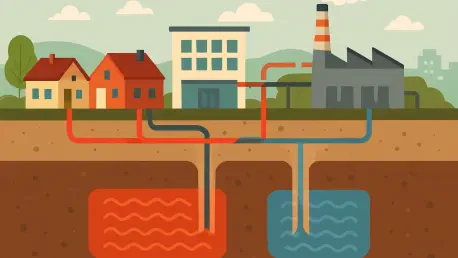Today, we’re thrilled to sit down with Christopher Hailstone, a seasoned expert in energy management, renewable energy, and electricity delivery. With his deep knowledge of grid reliability and innovative technologies, Christopher offers unique insights into the evolving landscape of sustainable energy solutions. As a utilities expert, he’s here to discuss a groundbreaking project by CenterPoint Energy—a networked geothermal pilot in Minnesota. This conversation will explore the inspiration behind this initiative, the technology’s potential to transform heating and cooling, the importance of community collaboration, and how this pilot aligns with broader decarbonization goals.
What sparked CenterPoint Energy’s interest in launching a networked geothermal pilot in Minnesota at this particular time?
The timing for this pilot really comes down to a mix of technological readiness and policy support. Minnesota’s Natural Gas Innovation Act, passed in 2021, created a framework for utilities like CenterPoint to invest in renewable and innovative solutions. This gave us a strong push to explore options beyond traditional natural gas. Plus, networked geothermal technology has matured to a point where it’s feasible for utility-scale pilots. We saw an opportunity to lead in this space, test the waters, and learn how these systems can fit into our energy future while meeting customer demand for cleaner solutions.
Can you break down what a networked geothermal system is and how it functions to heat and cool buildings?
Absolutely. A networked geothermal system is essentially a thermal energy network that uses the earth’s stable underground temperature as a heat source or sink. It involves a series of underground water pipes connected to heat pumps, which transfer heat to or from the ground to multiple buildings in an area—like a campus or neighborhood. In winter, it extracts heat from the earth to warm buildings, and in summer, it reverses the process to cool them by dumping excess heat back into the ground. When powered by renewable electricity, it’s a fantastic way to cut carbon emissions from building climate control.
How does this technology stand out compared to more conventional heating and cooling systems?
The big difference is efficiency and sustainability. Traditional systems often rely on burning fossil fuels or using electricity-intensive air conditioners, which can have a hefty carbon footprint. Networked geothermal systems, on the other hand, leverage a natural, consistent heat source—the earth itself—which drastically reduces energy waste. They’re also designed to serve multiple buildings at once, unlike individual heat pumps, making them more scalable for urban or campus settings. The upfront costs can be higher, but the long-term savings and environmental benefits are significant.
What made Resource Innovations and Salas O’Brien the right partners for CenterPoint in this geothermal pilot?
We chose these partners for their complementary expertise. Resource Innovations brings a strong background in energy efficiency and program design, which helps us evaluate the practical and economic aspects of potential sites. Salas O’Brien, meanwhile, offers deep engineering know-how, especially in thermal energy systems, which is critical for the technical design and feasibility studies. Together, they’re helping us pinpoint the best locations and ensure the project’s viability from both a financial and operational standpoint.
What key factors are you considering when selecting a site for this pilot project?
Site selection is a careful balancing act. We’re looking for areas with a good mix of building types—think residential, commercial, and public spaces—so the energy load is balanced throughout the year. A critical piece is finding an “anchor customer,” like a large institution or complex with significant energy needs, to stabilize demand. Proximity to existing infrastructure, geological suitability for drilling, and community interest also play big roles. We want a site where the impact will be measurable and the project can serve as a model for future efforts.
How has the response been from local communities and municipalities as you’ve reached out about this initiative?
We’ve been encouraged by the interest so far. Since launching outreach late last year, several communities have expressed curiosity about how this could fit into their sustainability plans. Some see it as a way to meet ambitious carbon-neutral goals, especially in areas like Minneapolis, where there’s a strong push for renewable energy by 2030. While we’re still in early discussions, the feedback has been positive, and we’re excited to deepen those conversations as we narrow down potential sites.
How does Minnesota’s Natural Gas Innovation Act tie into this geothermal pilot and CenterPoint’s broader innovation efforts?
The Act has been a game-changer. It essentially opened the door for utilities to step outside the box and invest in technologies like networked geothermal, renewable natural gas, and green hydrogen. For this pilot specifically, it provided the regulatory support and framework to justify the investment and experimentation. Beyond geothermal, we’re also exploring hybrid gas-electric heating systems and other projects under our five-year innovation plan. The Act encourages us to think long-term about decarbonizing our operations, and it’s exciting to be part of that shift.
What kind of impact do you think networked geothermal systems could have on decarbonization efforts in the building sector?
The potential is enormous. Buildings are a major source of carbon emissions, largely due to heating and cooling. Networked geothermal systems, especially when paired with renewable electricity, can slash those emissions by replacing fossil fuel-based systems. Depending on the setup, we could see reductions of 50% or more compared to traditional methods. The challenge lies in scaling up—there are upfront costs, regulatory hurdles, and the need for public awareness. But as a utility, if we can demonstrate success with this pilot, it could pave the way for wider adoption.
What’s your forecast for the future of networked geothermal systems in the United States over the next decade?
I’m optimistic but realistic. Over the next ten years, I expect we’ll see a slow but steady increase in adoption, especially in states like Minnesota, Massachusetts, and others with supportive policies. As more pilots like ours prove the technology’s reliability and cost-effectiveness, utilities and municipalities will gain confidence to invest. The push for decarbonization will be a major driver, but it’ll require collaboration across sectors—government, utilities, and private industry—to overcome financial and logistical barriers. If we can crack that code, networked geothermal could become a cornerstone of sustainable urban energy systems.









